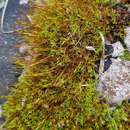en
names in breadcrumbs


I agree with W. C. Steere (1938) that large specimens with lamina beyond mid leaf plane and dentate (P. M. Eckel 1990b) intergrade (e.g., Alaska, Worley 6248, DUKE) completely with the typical variety. The British Columbia specimen (Schofield 15257, CAN) originally identified as Bryoerythrophyllum alpigenum but referred to B. jamesonii (Taylor) H. A. Crum by R. H. Zander (1978g) is a long-leaved variant with leaves plane and dentate in the distal half as in what has been referred to as var. dentatum, but also has the rather narrow and not sharply differentiated proximal cells of B. jamesonii (Taylor) H. A. Crum, an essentially Latin American species; but because the British Columbia specimen and others like it are much outside the range of the latter, are sterile (the last latter is dioicous), and occur in an hyperoceanic area known for taxon variants of large stature, it is best taken as a large form of B. recurvirostrum.
Bryoerythrophyllum recurvirostrum is generally synoicous or paroicous, but antheridia may not be present in every inflorescence. There is a great range of variation in sexuality in this species. Occasionally small male buds may be present on soil at the base of stems (e.g., Manitoba, Crum et al. 65c, CAN), indicating rhizautoicy. Some superficially dioicous specimens have distinctive broad leaf apices and nearly plane margins, but plants with typical leaves with narrow apicies and long-recurved margins may also exhibit rhizautoicy. One subarctic specimen (Ontario, Kenora District, Polar Bear Park, Williams 4022, CAN) was autoicous (as described for the species in general by E. Lawton (1971), another from Colorado (Weber, Kunkel & Munger B-46226, MO) was definitely cladautoicous, while one from Arizona (Haring 12262, MO) had both typically synoicous inflorescences and gemmate perigonia as has the var. aeneum (Müller Hal.) R. H. Zander of Mexico, but lacked the characteristic rhizoidal brood bodies of that taxon.